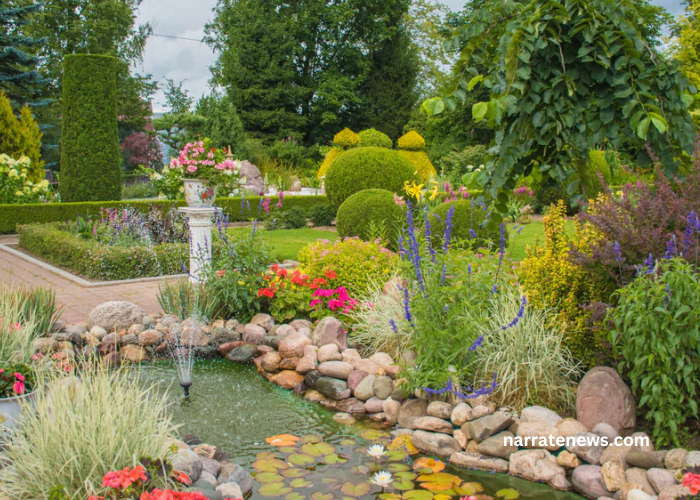
Blooms of Beauty: Flower Garden Aesthetics
In the tapestry of nature’s artistry, flower gardens stand as enchanting canvases where vibrant hues, delicate petals, and intoxicating fragrances weave a symphony of visual and olfactory delight. The flower garden aesthetic, with its timeless allure, has captivated hearts and inspired creativity across cultures and centuries. In this exploration, we embark on a journey through the kaleidoscope of flower gardens, delving into the history, design principles, and the profound impact these botanical masterpieces have on our senses and well-being.
The Historical Tapestry of Flower Garden Aesthetics
Ancient Gardens of Beauty:
The love affair between humanity and flower gardens has roots in ancient civilizations. From the Hanging Gardens of Babylon to the imperial gardens of ancient China, these curated spaces were not only expressions of aesthetic sensibilities but also symbols of prestige and connection to the divine.
Renaissance Elegance:
The Renaissance era witnessed a resurgence of interest in art, culture, and the natural world. Formal flower gardens adorned the estates of nobility, reflecting geometric precision and an integration of symbolic elements. Flowers became not just ornamental but carriers of meaning, conveying sentiments and messages through carefully chosen blooms.
Victorian Romanticism:
The Victorian era embraced the romanticism of flower gardens with fervor. The language of flowers, or floriography, reached its zenith during this period, as each bloom held specific meanings. The Victorian garden, abundant with roses, lilies, and pansies, became a canvas for expressing sentiments and emotions.
Modern Manifestations:
In the 20th and 21st centuries, flower gardens have evolved to embrace a blend of tradition and innovation. From traditional cottage gardens to contemporary landscape designs, the aesthetic appeal of flower gardens continues to thrive, adapting to changing tastes and lifestyles.
Design Principles of Flower Gardens
Color Harmony:
The play of colors is a fundamental aspect of flower garden aesthetics. Designing with a keen eye for color harmony involves understanding the color wheel, selecting complementary or contrasting hues, and orchestrating a visual symphony that evolves with the seasons.
Seasonal Dynamics:
Successful flower garden design considers the ephemerality of blooms. Strategic planting ensures a succession of flowers throughout the seasons, providing ever-changing vistas that captivate visitors year-round. From the delicate blossoms of spring to the robust colors of autumn, seasonal dynamics contribute to the garden’s aesthetic richness.
Structural Elements:
Beyond flowers, the inclusion of structural elements such as pathways, arches, and focal points adds depth and visual interest to a garden. Well-placed sculptures, trellises, and water features enhance the overall aesthetic, creating a harmonious balance between the softness of blooms and the solidity of design.
Biodiversity and Ecology:
Modern flower garden aesthetics embrace ecological considerations. Designing gardens that support biodiversity, attract pollinators, and maintain ecological balance adds a layer of environmental consciousness to the aesthetic experience. Wildflower meadows and native plantings contribute to sustainable and ecologically vibrant gardens.
The Sensory Symphony of Flower Gardens
Visual Splendor:
At the heart of flower garden aesthetics is the sheer visual splendor. The arrangement of blooms, the interplay of colors, and the overall design evoke a sense of wonder and delight. From the meticulous order of formal gardens to the wild chaos of cottage gardens, each style offers a unique visual feast.
Aroma Therapy:
Flower gardens are not just visual delights; they are also olfactory havens. The fragrances of roses, lavender, jasmine, and countless other blooms create an immersive sensory experience. Aromatherapy enthusiasts often find solace and relaxation in the scented embrace of a well-designed flower garden.
Soundscapes of Nature:
In a flower garden, the symphony of nature extends beyond the visual and olfactory realms. The gentle rustle of leaves, the humming of bees, and the song of birds contribute to a multi-sensory experience. Flower gardens become not just places of quiet beauty but also sanctuaries of natural sounds.
Tactile Pleasures:
Engaging with a flower garden involves more than just visual appreciation. The tactile pleasures of running fingers over velvety petals, feeling the coolness of leaves, and digging hands into the soil connect visitors directly to the living essence of the garden. Sensory engagement adds a layer of intimacy to the overall aesthetic experience.
Cultivating Well-being Through Flower Gardens
Therapeutic Horticulture:
Numerous studies attest to the therapeutic benefits of interacting with nature, and flower gardens, in particular, play a pivotal role in therapeutic horticulture. The act of gardening, surrounded by blooms and greenery, has been linked to stress reduction, improved mood, and enhanced overall well-being.
Mindfulness and Meditation:
The serene and contemplative ambiance of a flower garden provides an ideal setting for mindfulness and meditation. The rhythmic tasks of gardening, coupled with the visual and sensory stimuli, create an environment conducive to reflection, relaxation, and a heightened sense of presence.
Community Bonding:
Beyond personal well-being, flower gardens serve as communal spaces that foster connection and community bonding. Public gardens, botanical parks, and neighborhood flower beds become shared canvases where people gather, share stories, and collectively appreciate the beauty of nature.
Educational Spaces:
Flower gardens are living classrooms where individuals, especially children, can learn about plant life, ecosystems, and the importance of biodiversity. Educational programs conducted in botanical gardens and school flower beds nurture a love for nature and environmental stewardship.
Contemporary Trends and Innovations
Sustainable Gardening:
In response to environmental concerns, sustainable gardening practices have gained prominence. Rain gardens, green roofs, and xeriscaping are examples of eco-friendly approaches that align with the principles of flower garden aesthetics while minimizing ecological impact.
Vertical Gardens and Small Spaces:
As urban living becomes more prevalent, the adaptation of flower gardens to small spaces and vertical structures has become a trend. Vertical gardens, hanging planters, and compact flower beds offer solutions for urban dwellers to infuse their spaces with the beauty of blooms.
Technological Integration:
Advancements in technology have found their way into flower gardens. Smart irrigation systems, automated plant care devices, and augmented reality apps for garden planning are examples of how technology enhances the gardening experience, making it more accessible and efficient.
Conclusion: A Tapestry of Endless Beauty
In the grand tapestry of horticultural artistry, flower gardens stand as perennial symbols of beauty, creativity, and the enduring connection between humanity and nature. From ancient civilizations to modern urban landscapes, the flower garden aesthetic continues to evolve, weaving together history, design principles, sensory experiences, and well-being. As we cultivate our gardens—whether on expansive estates or tiny balconies—we contribute to this ongoing narrative of natural splendor, ensuring that the timeless allure of flower gardens persists for generations to come. In each petal, each fragrance, and each season, the beauty of flower gardens beckons us to immerse ourselves in the profound and ever-changing aesthetic embrace of nature’s blooms.


